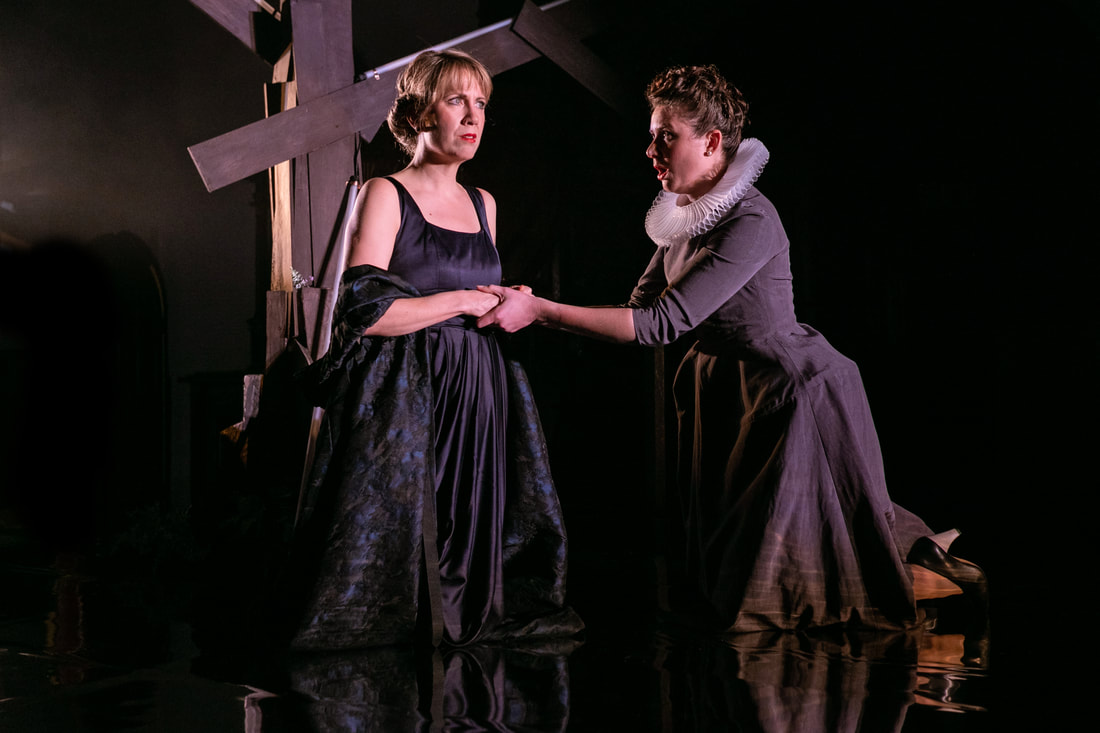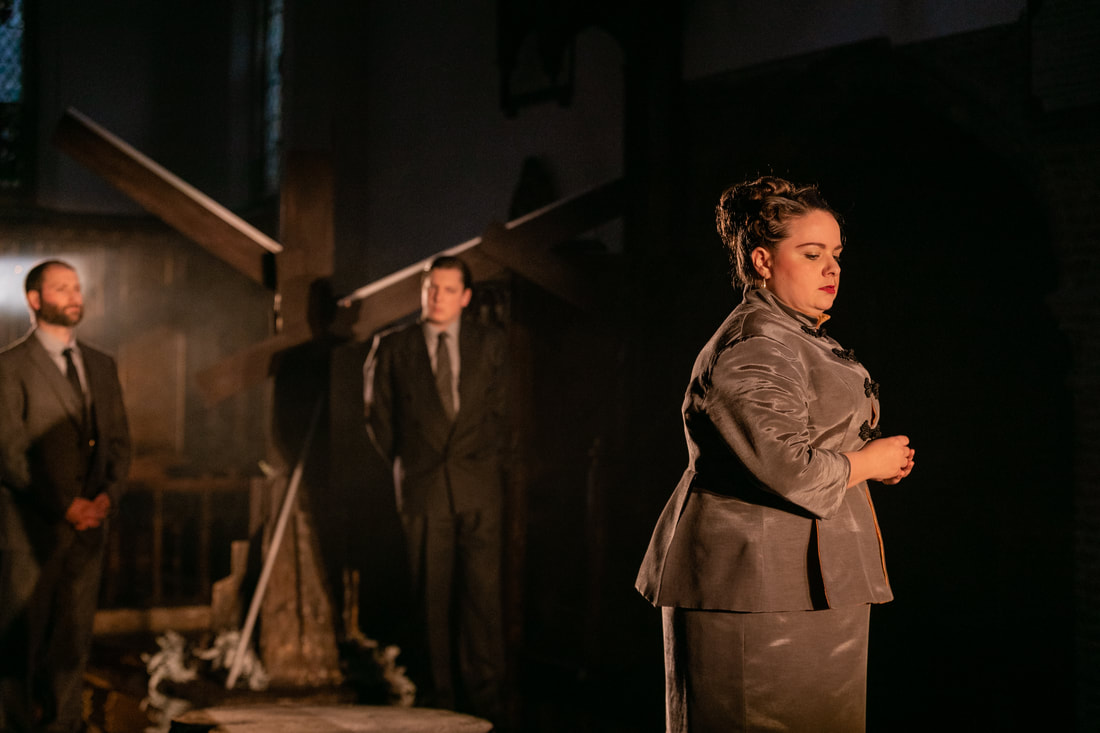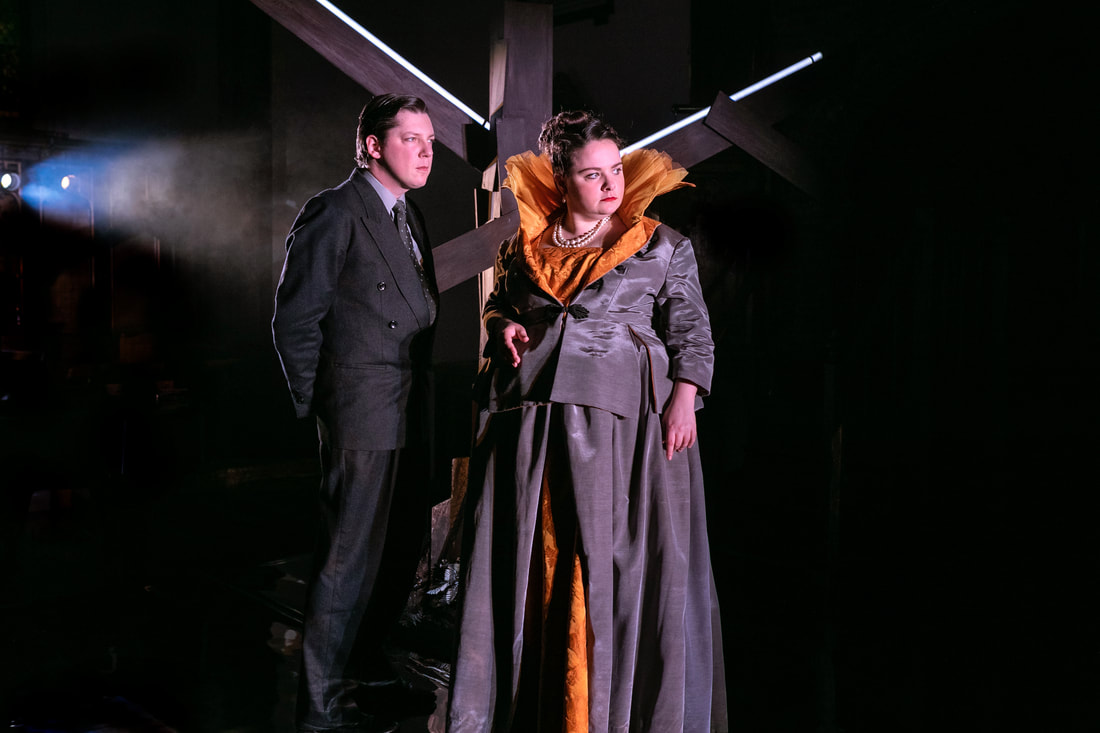Donizetti's Mary Queen of Scots by Opera Up Close The Old Church, Stoke Newington and touring April - June
Review by Howard Gray
The political machinations and turbulent love lives of English and Scottish royalty during Tudor times held considerable fascination for Europeans in the early 19th century. There were at least 15 operas in Italy alone concerning the eponymous decapitated Stuart. Visiting The Old Church in Stoke Newington completed a recent hat trick of Tudor era royal operas in north London for me that began at the Holy Cross Cross church in Kings Cross last August with the bold new solo opera “Mary’s Hand” - the story of Bloody Queen Mary I. This was followed in March by English Touring Opera’s version of Rossini’s “Elisabetta, Regina d’Inghilterra”, which brought its full chorus and orchestra bel canto crowd pleasers to the Hackney Empire. Rossini’s version of Elizabeth I is canonised by the somewhat Anglophile composer and his librettist - in contrast with tonight’s virgin, killer queen...
Opera Up Close are the Olivier Award-winning company known for innovative, accessible, affordable re-imaginings of well known works, as well as ground-breaking new operas. For tonight’s Mary, Queen of Scots, their new English language version - updated from Bardari’s original libretto by director Robin Norton-Hale and orchestrated by Paul McKenzie for only six singers and three musicians - is in intimate, explosive contrast to the stories of her older cousins. Taking place in the only surviving Elizabethan church in the capital, Donezetti’s bel canto opera comes to life in this compact, contemporaneous space, with its stained glass, pointed arches, altar, recesses, pulpit, tracery windows and very fine 16th century brickwork. It’s the perfect setting for experiencing the drama and intensity of Rossini’s confrontational duets up close and personal. Here, as in Schiller’s play (source of the original story), Elizabeth I is portrayed as vindictive, easily led and vengeful, and her cousin as the noble victim martyr.Opera Up Close are the Olivier Award-winning company known for innovative, accessible, affordable re-imaginings of well known works, as well as ground-breaking new operas. For tonight’s Mary, Queen of Scots, their new English language version - updated from Bardari’s original libretto by director Robin Norton-Hale and orchestrated by Paul McKenzie for only six singers and three musicians - is in intimate, explosive contrast to the stories of her older cousins. Taking place in the only surviving Elizabethan church in the capital, Donezetti’s bel canto opera comes to life in this compact, contemporaneous space, with its stained glass, pointed arches, altar, recesses, pulpit, tracery windows and very fine 16th century brickwork. It’s the perfect setting for experiencing the drama and intensity of Rossini’s confrontational duets up close and personal. Here, as in Schiller’s play (source of the original story), Elizabeth I is portrayed as vindictive, easily led and vengeful, and her cousin as the noble victim martyr.
‘Maria Stuarda’ was the second of the ‘Three Donizetti Queens’ operas, written after his first big international smash hit ‘Anna Bolena’. ‘Roberto Devereux’, about the reputed lover of Queen Elizabeth I, would be the third. This orchestration is revised for piano, cello and clarinet, which is just right in such an intimate space. The new libretto stands up well and is especially enjoyable in the cascading choruses, where one can appreciate the interplay in the original score writing. The unimposing set design, with its mirrored floor, means the compact, historic venue becomes the set, with the audience feeling very present within it.
To hear such fine voices just a few feet away in such a lovely acoustic space was a treat. Cliff Zammit Stevens’ powerful pleading emotive tenor is superb as Earl Leicester, especially in his early duets with Elizabeth, a reminder of how outstanding he was in last year’s ‘Eugene Onegin’. Jan Capinski, as a wonderfully taciturn Lord Cecil, brings the requisite baritone manipulative gravitas. Anna, the faithful companion, played by mezzo Anna Watkinson, gives emotional support to the end. Bass Julian Debreuil as Lord Talbot intones in vain for mercy.
A highlight of the production is its most famous, properly outrageous moment: the soprano duet duel between the rival queens at the end of Act One. It is visceral. Historically these queens are known to have exchanged letters but this face-to-face meeting was Schiller’s fiction. In it sparks fly, scandalous insults are hurled and it delivers a soprano shoot-out at point blank range.
Our sopranos do justice to the profoundly tragic, complex figures, caught in their own Game of Thrones. The excellent Philippa Boyle as Elizabeth is unrestrained in her portrayal of willful jealousy, delivered with real power. Fiona Macintosh in the title role grips us throughout as - despite her protests of innocence - she goes gracefully, singing with élan to the inevitable bloodthirsty climax.
It’s called Opera Up Close for a reason.
Opera Up Close are taking Mary Queen of Scots to a further selection of sublime settings in London and the south east - details below
https://www.operaupclose.com/maria-stuarda
The Charterhouse, Clerkenwell, London 24 - 29 April Book Here
Blackfriars Priory, Gloucester, 1 May Book Here
Exeter Guildhall, Exter, 3 May Book Here
Poltimore House, Exeter 4 May Book Here
Glastonbury Abbey, 22 June Book Here
The Charterhouse, Clerkenwell, London 24 - 29 April Book Here
Blackfriars Priory, Gloucester, 1 May Book Here
Exeter Guildhall, Exter, 3 May Book Here
Poltimore House, Exeter 4 May Book Here
Glastonbury Abbey, 22 June Book Here
share


